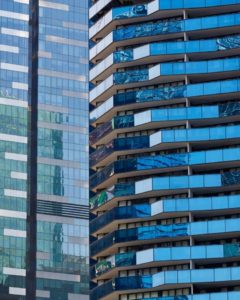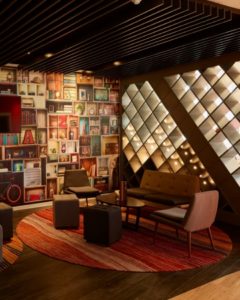Recovering from a travel-induced cold, I decided at 9:35 to buy a virtual ticket for the latest Workplace Trends 2022 meeting starting at 9:45. Must be healthier and better prepared in 2023.
The morning session chair was Nigel Oseland (Workplace Unlimited) who welcomed lots of new faces to the meeting and encouraged them to make use of the breaks in the programme to talk to other members of the workplace community.
The opening presentation was by Paul Urmiston (NatWest) who touched upon the transformation of the NatWest estate over the years and particularly discussed the workspace hub on the third floor of the 250 Bishopsgate building. Designed for changing and growing teams, it was a marked departure from the previous desk-heavy environment with seamless technology, variations in lighting, and active community managers being key to how the space works. Paul was honest and said that people aren’t using all the spaces and are creatures of habit, but compared to other floors there is a greater buzz in this space (no utilisation / floor but 50% occupancy was seen by NatWest – across 3500 desks in the building – as not being a concern). Some change management in how to use the spaces is now being carried out. On the question of dynamic stacking Paul commented that not all buildings can be shut down in stages and for larger buildings where there is a service offering such as a café, supply staff can’t easily respond to changing demand – they need to plan for a certain number of staff.
Gary Thornton (Nulty) gave an interesting presentation on lighting design and how the crossover between hospitality and commercial is providing more opportunities for human-centric lighting. He added that “lighting is for people and not for carpets”, so add lighting where it needs to be and where activities take place. Examples showed task lighting plus down-lighting rather than the standard Cat A fit-out ceiling plus an interactive lift lobby that certainly grabs people’s attention. Gary also touched on the lighting of living walls and stated that artificial lighting needs a lot of Watts and therefore might not be as sustainable as people think.
A double act of Will Easton (VMO2) and Chris Moriarty (Audiem / 3edges) showed how stories are important to engagement and understanding user experience, and how using AI could allow the free text comments in staff surveys to be analysed far quicker while still providing excellent insights. Using technology removes guesswork and provides holistic, data-led evidence which improves the quality of the conversation and ultimately supports better decision making. Questions touched upon data imbalance from opinionated people (“true with any survey”) and opportunities for real-time data analysis from vocal inputs (to help reach under-represented colleagues). It was agreed that interviews still allow you to delve deeper (which we heard at the last meeting – “surveys give you breadth, interviews give you depth”).
Gillian Stewart (MLA) presented four case studies at Workplace Trends 2022 with accompanying short videos to give us a mini-break from slideshow overload. Their work with Brodies, the National Robotarium, Glenkinchie Distillery and the Scottish Bible Society highlighted the importance of engagement and involving the community in order to develop the brief. One of the questions touched upon working across sectors and Gillian mentioned that many clients are not interested so much in what is happening in other sectors, but are keen to know what their competitors are doing.
The pre-lunch, left-field presentation of this meeting was from Deborah Kempson-Wren (Managing Ourselves) and was all about mindfulness and how we need to minimise the number of daily distractions and fire-fighting activities as these can completely derail you. She presented research that showed we’re effectively working on auto-pilot 47% of the time and discussed how productive time is made up of larger chunks (while most of us are struggling with time confetti, where we’re scrambling about with small pieces of time). Deborah’s voice over the live stream was so soothing that I was in meditation mode well before she asked us to close our eyes!
With Jeremy Campbell (EMCOR) as the afternoon’s host, we started with a panel discussion on office densities chaired by Rob Harris (Ramidus) who was joined by Nigel Oseland, Tim Oldman (Leesman), Gillian Stewart and Bridget Workman (The Changing Work Company). The range of topics of future workplace trends included:
- density being less important than user experience
- managing demand and what to do with buildings on quieter days
- do we even need offices when the average home supports the worker better than the average office
- mandates for attendance
- oversupply of office space and what to do with the really poor offices
- thinking of the hierarchy of service: client (1st), team (2nd) and individual (3rd).
Was there a consensus? Not really. Did we expect one? Not really.
The best presentation of the day in my opinion was by Peter Cheese (CIPD) because of the content but also the passion in his delivery. As a fellow virtual attendee commented, “it was a coup to get Peter to present – really impressive”. His talk was all about current challenges to the world of work –from the pandemic to geopolitics – and the changing dynamics of the labour market (and how we need to remember that work is about the people). We need to shape the future and ED&I (Equality, Diversity & Inclusion) is now a business critical agenda, giving companies greater access to skills and access to more innovative and creative thinking. ED&I is now an expectation from new talent. His talk also touched upon health and wellbeing, with the top three causes of stress being workload / volume of work, management style and relationships at work. With regard to the second, training managers and looking for an ethical outlook over competence was key. I would urge you to search for any content from Peter online – as I said, this was a really great presentation.
We were then joined all the way from New Zealand in the wee small hours by Charlotte Lockhart (4 Day Week Global) to bring us up to date with results from ongoing pilot projects around the world on the 4 day week. Key to the success of the pilots was talking with staff and not overthinking it – it needs to be supported from the top, but is really a bottom-up process. Some of the benefits of the 4 day week were listed: potentially reducing losses due to work-related stress (£33–43 billion per annum in the UK alone), staff attraction / retention (time off used for socialising or volunteering), and helping the environment (in the UK a 4 day week would be the equivalent of removing all private vehicles off the road). An interesting question related to the potential for a two-tier system with organisations like the NHS not able to participate in a 4 day week due to the nature of their service. Charlotte’s response was that a 4 day week would result in rested NHS staff and better health in the wider public, leading to less demand for treatment by the NHS.
Perry Timms (PTHR) gave a talk which was quite technical in terms of new organisational structures to support hybrid working. I didn’t even write down the acronyms, but from his abstract they were DAOs, MEs and NSEVs – Decentralised Autonomous Organisations, Micro Enterprises and Next Stage Evolutionary Ventures. Quoting research by others (and I may be incorrectly paraphrasing here) he stated that we might save $10–18 trillion from removing excess bureaucracy and $8 trillion from avoiding wasted ingenuity. We should be less concerned about income generation from our people and more focused on our people creating an impact.
The final talk of the day at Workplace Trends 2022 was a discussion between Mark Catchlove (Miller Knoll) and author / change manager Jennifer Bryan. Some of the key questions around change are Why?, Why now?, and Why should anyone care about the change? In terms of sponsoring and leading the change, it was important that the individual was active and visible within the organisation and was able to exert influence across the whole organisation.
And that was it. Unlike the last virtual meeting, there were no real serious technical glitches. Some interesting statistics and soundbites that I hope I scribbled down correctly. Time (and the accompany presentation videos) will tell if they are true.




